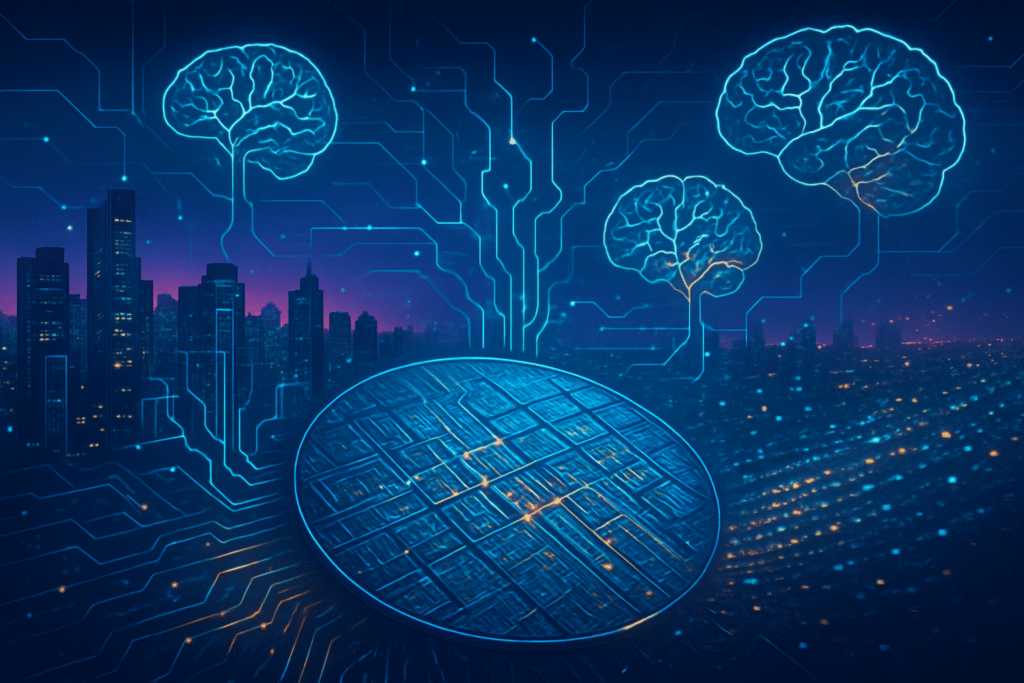
The technology sector is currently experiencing a remarkable surge in optimism, particularly evident in the robust performance of semiconductor stocks. This positive sentiment, observed around October 2025, is largely driven by the burgeoning "AI Supercycle"—an era of immense and insatiable demand for artificial intelligence and high-performance computing (HPC) capabilities. Despite broader market fluctuations and ongoing geopolitical concerns, the semiconductor industry has been propelled to new financial heights, establishing itself as the fundamental building block of a global AI-driven economy.
This unprecedented demand for advanced silicon is creating a new data center ecosystem and fostering an environment where innovation in chip design and manufacturing is paramount. Leading semiconductor companies are not merely benefiting from this trend; they are actively shaping the future of AI by delivering the foundational hardware that underpins every major AI advancement, from large language models to autonomous systems.
The Silicon Engine of AI: Unpacking Technical Advancements Driving the Boom
The current semiconductor boom is underpinned by relentless technical advancements in AI chips, including Graphics Processing Units (GPUs), Application-Specific Integrated Circuits (ASICs), and High Bandwidth Memory (HBM). These innovations are delivering immense computational power and efficiency, essential for the escalating demands of generative AI, large language models (LLMs), and high-performance computing workloads.
Leading the charge in GPUs, Nvidia (NASDAQ: NVDA) has introduced its H200 (Hopper Architecture), featuring 141 GB of HBM3e memory—a significant leap from the H100's 80 GB—and offering 4.8 TB/s of memory bandwidth. This translates to substantial performance boosts, including up to 4 petaFLOPS of FP8 performance and nearly double the inference performance for LLMs like Llama2 70B compared to its predecessor. Nvidia's upcoming Blackwell architecture (launched in 2025) and Rubin GPU platform (2026) promise even greater transformer acceleration and HBM4 memory integration. AMD (NASDAQ: AMD) is aggressively challenging with its Instinct MI300 series (CDNA 3 Architecture), including the MI300A APU and MI300X accelerator, which boast up to 192 GB of HBM3 memory and 5.3 TB/s bandwidth. The AMD Instinct MI325X and MI355X further push the boundaries with up to 288 GB of HBM3e and 8 TBps bandwidth, designed for massive generative AI workloads and supporting models up to 520 billion parameters on a single chip.
ASICs are also gaining significant traction for their tailored optimization. Intel (NASDAQ: INTC) Gaudi 3, for instance, features two compute dies with eight Matrix Multiplication Engines (MMEs) and 64 Tensor Processor Cores (TPCs), equipped with 128 GB of HBM2e memory and 3.7 TB/s bandwidth, excelling at training and inference with 1.8 PFlops of FP8 and BF16 compute. Hyperscalers like Google (NASDAQ: GOOGL) continue to advance their Tensor Processing Units (TPUs), with the seventh-generation TPU, Ironwood, offering a more than 10x improvement over previous high-performance TPUs and delivering 42.5 exaflops of AI compute in a pod configuration. Companies like Cerebras Systems with its WSE-3, and startups like d-Matrix with its Corsair platform, are also pushing the envelope with massive on-chip memory and unparalleled efficiency for AI inference.
High Bandwidth Memory (HBM) is critical in overcoming the "memory wall." HBM3e, an enhanced variant of HBM3, offers significant improvements in bandwidth, capacity, and power efficiency, with solutions operating at up to 9.6 Gb/s speeds. The HBM4 memory standard, finalized by JEDEC in April 2025, targets 2 TB/s of bandwidth per memory stack and supports taller stacks up to 16-high, enabling a maximum of 64 GB per stack. This expanded memory is crucial for handling increasingly large AI models that often exceed the memory capacity of older chips. The AI research community is reacting with a mix of excitement and urgency, recognizing the "AI Supercycle" and the critical need for these advancements to enable the next generation of LLMs and democratize AI capabilities through more accessible, high-performance computing.
Reshaping the AI Landscape: Impact on Companies and Competitive Dynamics
The AI-driven semiconductor boom is profoundly reshaping competitive dynamics across major AI labs, tech giants, and startups, with strategic advantages being aggressively pursued and significant disruptions anticipated.
Nvidia (NASDAQ: NVDA) remains the undisputed market leader in AI GPUs, commanding approximately 80% of the AI chip market. Its robust CUDA software stack and AI-optimized networking solutions create a formidable ecosystem and high switching costs. AMD (NASDAQ: AMD) is emerging as a strong challenger, with its Instinct MI300X and upcoming MI350/MI450 series GPUs designed to compete directly with Nvidia. A major strategic win for AMD is its multi-billion-dollar, multi-year partnership with OpenAI to deploy its advanced Instinct MI450 GPUs, diversifying OpenAI's supply chain. Intel (NASDAQ: INTC) is pursuing an ambitious AI roadmap, featuring annual updates to its AI product lineup, including new AI PC processors and server processors, and making a strategic pivot to strengthen its foundry business (IDM 2.0).
Hyperscalers like Google (NASDAQ: GOOGL), Microsoft (NASDAQ: MSFT), and Amazon (NASDAQ: AMZN) are aggressively pursuing vertical integration by developing their own custom AI chips (ASICs) to gain strategic independence, optimize hardware for specific AI workloads, and reduce operational costs. Google continues to leverage its Tensor Processing Units (TPUs), while Microsoft has signaled a fundamental pivot towards predominantly using its own Microsoft AI chips in its data centers. Amazon Web Services (AWS) offers scalable, cloud-native AI hardware through its custom chips like Graviton and Trainium/Inferentia. These efforts enable them to offer differentiated and potentially more cost-effective AI services, intensifying competition in the cloud AI market. Major AI labs like OpenAI are also forging multi-billion-dollar partnerships with chip manufacturers and even designing their own custom AI chips to gain greater control over performance and supply chain resilience.
For startups, the boom presents both opportunities and challenges. While the cost of advanced chip manufacturing is high, cloud-based, AI-augmented design tools are lowering barriers, allowing nimble startups to access advanced resources. Companies like Groq, specializing in high-performance AI inference chips, exemplify this trend. However, startups with innovative AI applications may find themselves competing not just on algorithms and data, but on access to optimized hardware, making strategic partnerships and consistent chip supply crucial. The proliferation of NPUs in consumer devices like "AI PCs" (projected to comprise 43% of PC shipments by late 2025) will democratize advanced AI by enabling sophisticated models to run locally, potentially disrupting cloud-based AI processing models.
Wider Significance: The AI Supercycle and its Broader Implications
The AI-driven semiconductor boom of October 2025 represents a profound and transformative period, often referred to as a "new industrial revolution" or the "AI Supercycle." This surge is fundamentally reshaping the technological and economic landscape, impacting global economies and societies, while also raising significant concerns regarding overvaluation and ethical implications.
Economically, the global semiconductor market is experiencing unparalleled growth, projected to reach approximately $697 billion in 2025, an 11% increase over 2024, and is on an ambitious trajectory towards a $1 trillion valuation by 2030. The AI chip market alone is expected to surpass $150 billion in 2025. This growth is fueled by massive capital expenditures from tech giants and substantial investments from financial heavyweights. Societally, AI's pervasive integration is redefining its role in daily life and driving economic growth, though it also brings concerns about potential workforce disruption due to automation.
However, this boom is not without its concerns. Many financial experts, including the Bank of England and the IMF, have issued warnings about a potential "AI equity bubble" and "stretched" equity market valuations, drawing comparisons to the dot-com bubble of the late 1990s. While some deals exhibit "circular investment structures" and massive capital expenditure, unlike many dot-com startups, today's leading AI companies are largely profitable with solid fundamentals and diversified revenue streams, reinvesting substantial free cash flow into real infrastructure. Ethical implications, such as job displacement and the need for responsible AI development, are also paramount. The energy-intensive nature of AI data centers and chip manufacturing raises significant environmental concerns, necessitating innovations in energy-efficient designs and renewable energy integration. Geopolitical tensions, particularly US export controls on advanced chips to China, have intensified the global race for semiconductor dominance, leading to fears of supply chain disruptions and increased prices.
The current AI-driven semiconductor cycle is unique in its unprecedented scale and speed, fundamentally altering how computing power is conceived and deployed. AI-related capital expenditures reportedly surpassed US consumer spending as the primary driver of economic growth in the first half of 2025. While a "sharp market correction" remains a risk, analysts believe that the systemic wave of AI adoption will persist, leading to consolidation and increased efficiency rather than a complete collapse, indicating a structural transformation rather than a hollow bubble.
Future Horizons: The Road Ahead for AI Semiconductors
The future of AI semiconductors promises continued innovation across chip design, manufacturing processes, and new computing paradigms, all aimed at overcoming the limitations of traditional silicon-based architectures and enabling increasingly sophisticated AI.
In the near term, we can expect further advancements in specialized architectures like GPUs with enhanced Tensor Cores, more custom ASICs optimized for specific AI workloads, and the widespread integration of Neural Processing Units (NPUs) for efficient on-device AI inference. Advanced packaging techniques such as heterogeneous integration, chiplets, and 2.5D/3D stacking will become even more prevalent, allowing for greater customization and performance. The push for miniaturization will continue with the progression to 3nm and 2nm process nodes, supported by Gate-All-Around (GAA) transistors and High-NA EUV lithography, with high-volume manufacturing anticipated by 2025-2026.
Longer term, emerging computing paradigms hold immense promise. Neuromorphic computing, inspired by the human brain, offers extremely low power consumption by integrating memory directly into processing units. In-memory computing (IMC) performs tasks directly within memory, eliminating the "von Neumann bottleneck." Photonic chips, using light instead of electricity, promise higher speeds and greater energy efficiency. While still nascent, the integration of quantum computing with semiconductors could unlock unparalleled processing power for complex AI algorithms. These advancements will enable new use cases in edge AI for autonomous vehicles and IoT devices, accelerate drug discovery and personalized medicine in healthcare, optimize manufacturing processes, and power future 6G networks.
However, significant challenges remain. The immense energy consumption of AI workloads and data centers is a growing concern, necessitating innovations in energy-efficient designs and cooling. The high costs and complexity of advanced manufacturing create substantial barriers to entry, while supply chain vulnerabilities and geopolitical tensions continue to pose risks. The traditional "von Neumann bottleneck" remains a performance hurdle that in-memory and neuromorphic computing aim to address. Furthermore, talent shortages across the semiconductor industry could hinder ambitious development timelines. Experts predict sustained, explosive growth in the AI chip market, potentially reaching $295.56 billion by 2030, with a continued shift towards heterogeneous integration and architectural innovation. A "virtuous cycle of innovation" is anticipated, where AI tools will increasingly design their own chips, accelerating development and optimization.
Wrap-Up: A New Era of Silicon-Powered Intelligence
The current market optimism surrounding the tech sector, particularly the semiconductor industry, is a testament to the transformative power of artificial intelligence. The "AI Supercycle" is not merely a fleeting trend but a fundamental reshaping of the technological and economic landscape, driven by a relentless pursuit of more powerful, efficient, and specialized computing hardware.
Key takeaways include the critical role of advanced GPUs, ASICs, and HBM in enabling cutting-edge AI, the intense competitive dynamics among tech giants and AI labs vying for hardware supremacy, and the profound societal and economic impacts of this silicon-powered revolution. While concerns about market overvaluation and ethical implications persist, the underlying fundamentals of the AI boom, coupled with massive investments in real infrastructure, suggest a structural transformation rather than a speculative bubble.
This development marks a significant milestone in AI history, underscoring that hardware innovation is as crucial as software breakthroughs in pushing AI from theoretical concepts to pervasive, real-world applications. In the coming weeks and months, we will continue to watch for further advancements in process nodes, the maturation of emerging computing paradigms like neuromorphic chips, and the strategic maneuvering of industry leaders as they navigate this dynamic and high-stakes environment. The future of AI is being built on silicon, and the pace of innovation shows no signs of slowing.
This content is intended for informational purposes only and represents analysis of current AI developments.
TokenRing AI delivers enterprise-grade solutions for multi-agent AI workflow orchestration, AI-powered development tools, and seamless remote collaboration platforms.
For more information, visit https://www.tokenring.ai/.






